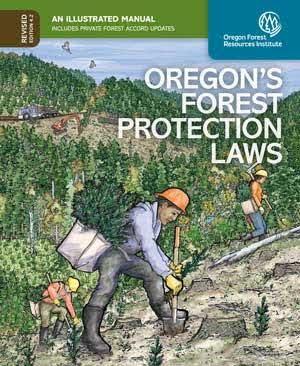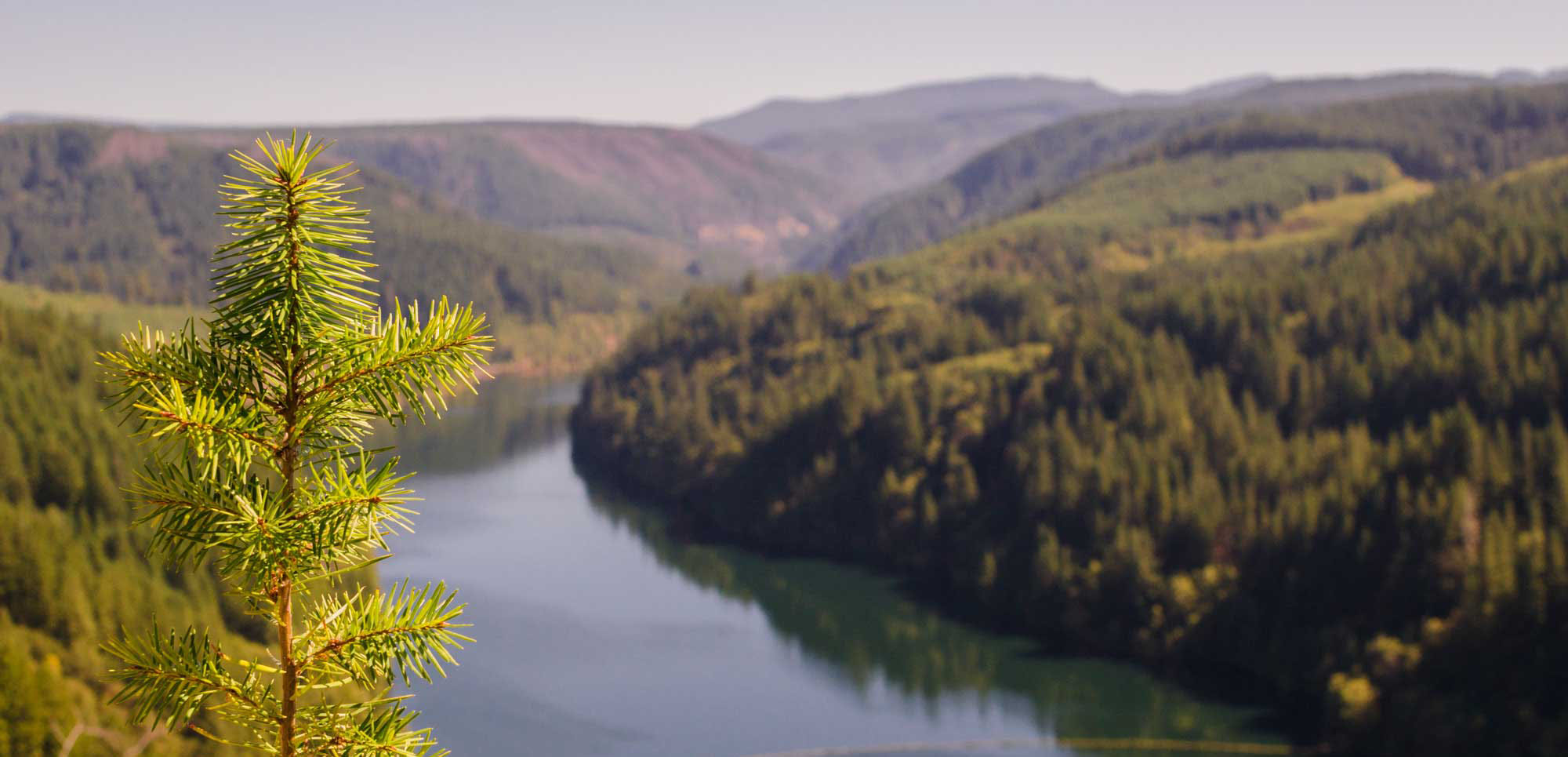Oregon has a long-standing commitment to forest stewardship, underscored by robust forest protection laws that help ensure sustainable management practices.
In 1971, Oregon became the first state in the nation to implement a comprehensive set of laws governing forest practices with the passage of the Oregon Forest Practices Act (OFPA). Since then, Oregon’s forest protection rules have continued to be revised as scientists learn more about forests and forest practices.
The most recent updates to the OFPA stemming from the Private Forest Accord agreement mark a significant evolution in these regulations, introducing substantial changes to enhance forest habitat protections, particularly for fish and amphibians, and establishing new guidelines for logging on steep slopes and constructing and maintaining forest roads. These changes underscore the importance of adhering to best management practices and regulations designed not only to protect our valuable forest resources, but also to support landowners in maintaining compliance and promoting environmental stewardship.
All laws under the OFPA apply to privately owned forestlands in Oregon and are regulated and enforced by the Oregon Department of Forestry (ODF). ODF foresters are available to offer guidance and ensure compliance with these laws. Find your local ODF forester on their “Find a Forester” webpage.

To help you navigate these updated regulations, the Oregon Forest Resources Institute (OFRI) has released a revised fourth edition of Oregon’s Forest Protection Laws: An Illustrated Manual. Order or download your free copy of the manual from OFRI’s publication library.
Below are additional resources offering guidance on major aspects of Oregon’s forest practice regulations.
Water and fish
The state regulations that are in place to protect water and fish include requirements to leave trees standing along streams to shade the water and provide better aquatic habitat in designated riparian management areas (RMAs), also called “stream buffers.” In these areas, which vary in width depending on the size of the stream and whether it contains fish (or certain species of fish), timber harvesting is either prohibited or restricted. Please see the resources listed below:
Technical Guidance: Equipment Limitation Zones and Retention-Equipment Limitation Zones
Stream Classification and Vegetation Retention
Small Type N Stream Guidance and Flow Permanence Field Survey Protocol
Western Oregon Stream RMA Matrix
Westside Forest Stream Protection Diagrams
Eastern Oregon Stream RMA Matrix
Eastside Forest Stream Protection Diagrams
Streams and Steep Slopes data viewer
Steep slopes
This regulation applies to landowners conducting logging operations on steep slopes and requires tree retention in specific areas to protect stream habitats below. While small forest landowners may operate on a smaller scale, they are still required to comply with these regulations under the OFPA. However, some qualifying small forest landowners may be exempt from certain rules. For more information, please refer to the resources listed below:
Technical Guidance: Identifying Slope Retention Areas
Technical Note: Determination of Rapidly Moving Landslide Impact Rating
Steep Slopes Model: Designated Debris Flow Traversal Areas
Streams and Steep Slopes data viewer
Certified Steep Slopes Training
Reforestation
Forest landowners are required by Oregon law to establish the next generation of trees after harvesting timber. State requirements for landowners include replanting within a certain time frame after harvest, ensuring successful reforestation, planting a certain number of trees per acre, and selecting tree species that are suited to the region where they will be planted.
Under state law, reforestation is considered successful if the seedlings are “free to grow” within six years of being planted — meaning the young trees are no longer hindered by competing vegetation because they have grown sufficiently tall and vigorous.
Learn more about reforestation by visiting the planting trees page of this website.
Wildlife habitat
Forest landowners should be aware of sensitive wildlife habitats that may exist on their property. This includes habitats for fish, amphibians, birds and other species regulated under federal and/or Oregon law. ODF provides specific guidelines for protecting these species, which may include restrictions on logging activities during critical periods such as nesting seasons for certain bird species. Landowners are encouraged to consult these guidelines to ensure compliance with state and federal regulations.
For more information about regulated species and their protections, visit the regulated species page of this website.
Logging
Some crucial state rules that apply to logging include limiting the size of clearcuts to 120 acres and requiring that clearcuts not be closer than 300 feet to another clearcut.
For logging operations of 25 acres or more, there must be two live trees, or two dead standing trees left, and two down logs must be present where trees have been cut to provide habitat for wildlife.
Depending on the site class, clearcuts that are greater than 25 acres generally must be replanted with at least 200 trees per acre within two years. Laws that pertain to no-cut stream buffers (RMAs) are enforced during all types of logging operations.
For more information about logging and selling timber, visit the logging and selling timber page of this website.
Chemical application
Since forest landowners are required by law to ensure that trees are “free to grow” within six years, some landowners choose to apply herbicides to control vegetation that is competing with tree seedlings they have planted or that have regenerated naturally after a timber harvest.
Herbicides are chemicals that can be hazardous to humans, animals and wildlife, so federal and state laws limit herbicide use in forests and require landowners who use them to take special precautions. Oregon law requires forest landowners to follow strict guidelines for herbicide application, including protecting water quality, maintaining no-spray buffer zones, and adhering to licensing and notification rules. For more information, please refer to the resources listed below:
Chemicals and Other Petroleum Products — Forest Practice Notes No. 3
Forestry Fact Sheet: Herbicide Use in Forestry
Daily Chemical Application Record Form
Forest roads
State regulations for forest roads ensure that their construction and use minimize environmental impacts and maintain long-term functionality.
Landowners are required to develop a written plan for road construction projects, especially when operations occur near sensitive areas such as streams and other critical locations. Roads must be engineered for durability, including properly designed stream crossings, such as culverts and bridges, that account for fish passage and water flow.
Additional requirements apply during wet weather, including measures to prevent erosion and restrictions on use. For more information, please refer to the resources listed below:
Technical Guidance: Road Condition Assessment for Small Forestland Owners
Technical Guidance: Avoiding Roads in Critical Locations
Road Condition Assessment Training video
Visual management
Any timber harvesting operation along a scenic highway must have a buffer of trees that is 150 feet wide along the roadside and contains at least 50 trees per acre. When the trees that have been planted behind the buffer have reached at least 10 feet tall, the 150-foot buffer can be harvested. This practice can be done in reverse, but either way, the harvest must be completed in two parts. Additionally, reforestation in a scenic corridor needs to be completed within one year instead of the usual two.
Public notification
ODF operates an e-notification system known as the Forest Activity Electronic Reporting and Notification System (FERNS). Under the OFPA, forest landowners — or individuals working on their behalf, such as consulting foresters, loggers or pesticide applicators — are required to notify ODF at least 15 days before the start of any forest operation. This allows members of the public to subscribe to FERNS to get information about forest operations and register to be informed about planned helicopter pesticide use within 1 mile of their home or surface water intake.
Forest operations include activities such as logging, road construction, debris burning and chemical application. For aerial chemical applications using helicopters, notifications must be submitted to ODF 30 days in advance if there is at least one member of the public who has registered through FERNS to receive information about helicopter pesticide application near their home or water intake, or 15 days in advance if there are no registrants.
For more information about FERNS, please refer to this resource:
e-Notification System (FERNS) New Changes Training
“Small forestland owners”
Under Oregon law, “small forestland owners” (or “SFOs”) differ from industrial forest landowners in terms of property size, location and resource capabilities, and therefore qualify for state assistance. To qualify as an SFO in Oregon, a landowner must meet the following criteria:
- Owns, wholly or in part, less than 5,000 acres of forestland in Oregon.
- Has harvested no more than an average of 2 million board feet of timber per year over the past three years.
- Does not anticipate harvesting more than an average of 2 million board feet per year over the next 10 years.
ODF’s Small Forestland Owner Office [link to https://www.oregon.gov/odf/working/pages/sfo.aspx] provides resources and assistance to landowners who meet these criteria.
Key state programs also help SFOs achieve sustainable management goals while addressing challenges. They include:
- Small Forestland Investment in Stream Habitat Program: Supports stream habitat restoration and improvement projects on small forestlands.
- Forest Conservation Tax Credit Program: Offers tax incentives to encourage conservation and sustainable forest management practices.
ADDITIONAL RESOURCES
PUBLICATIONS
Forest Practice Administrative Rules and the Forest Practices Act
This publication details resource protection rules and legal statutes for forest practices in Oregon.

